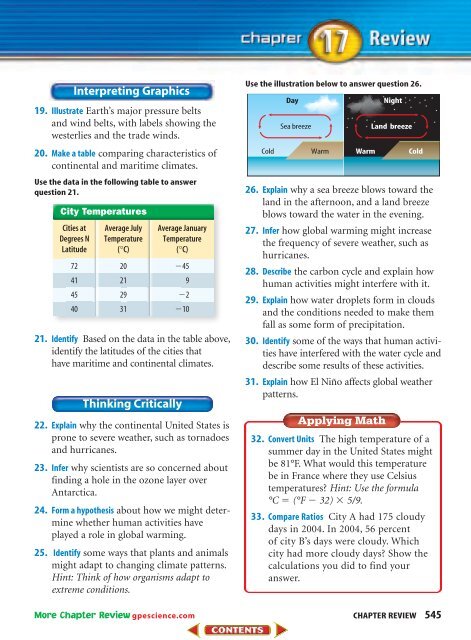CHAPTER 17 Weather and Climate - Mr. Barrow's Science Center
CHAPTER 17 Weather and Climate - Mr. Barrow's Science Center
CHAPTER 17 Weather and Climate - Mr. Barrow's Science Center
You also want an ePaper? Increase the reach of your titles
YUMPU automatically turns print PDFs into web optimized ePapers that Google loves.
Interpreting Graphics19. Illustrate Earth’s major pressure belts<strong>and</strong> wind belts, with labels showing thewesterlies <strong>and</strong> the trade winds.20. Make a table comparing characteristics ofcontinental <strong>and</strong> maritime climates.Use the data in the following table to answerquestion 21.City TemperaturesCities at Average July Average JanuaryDegrees N Temperature TemperatureLatitude (°C) (°C)72 20 4541 21 945 29 240 31 1021. Identify Based on the data in the table above,identify the latitudes of the cities thathave maritime <strong>and</strong> continental climates.Use the illustration below to answer question 26.ColdDaySea breezeWarmWarmNightL<strong>and</strong> breezeCold26. Explain why a sea breeze blows toward thel<strong>and</strong> in the afternoon, <strong>and</strong> a l<strong>and</strong> breezeblows toward the water in the evening.27. Infer how global warming might increasethe frequency of severe weather, such ashurricanes.28. Describe the carbon cycle <strong>and</strong> explain howhuman activities might interfere with it.29. Explain how water droplets form in clouds<strong>and</strong> the conditions needed to make themfall as some form of precipitation.30. Identify some of the ways that human activitieshave interfered with the water cycle <strong>and</strong>describe some results of these activities.31. Explain how El Niño affects global weatherpatterns.22. Explain why the continental United States isprone to severe weather, such as tornadoes<strong>and</strong> hurricanes.23. Infer why scientists are so concerned aboutfinding a hole in the ozone layer overAntarctica.24. Form a hypothesis about how we might determinewhether human activities haveplayed a role in global warming.25. Identify some ways that plants <strong>and</strong> animalsmight adapt to changing climate patterns.Hint: Think of how organisms adapt toextreme conditions.More Chapter Review gpescience.com32. Convert Units The high temperature of asummer day in the United States mightbe 81°F. What would this temperaturebe in France where they use Celsiustemperatures? Hint: Use the formula°C (°F 32) 5/9.33. Compare Ratios City A had <strong>17</strong>5 cloudydays in 2004. In 2004, 56 percentof city B’s days were cloudy. Whichcity had more cloudy days? Show thecalculations you did to find youranswer.<strong>CHAPTER</strong> REVIEW 545


